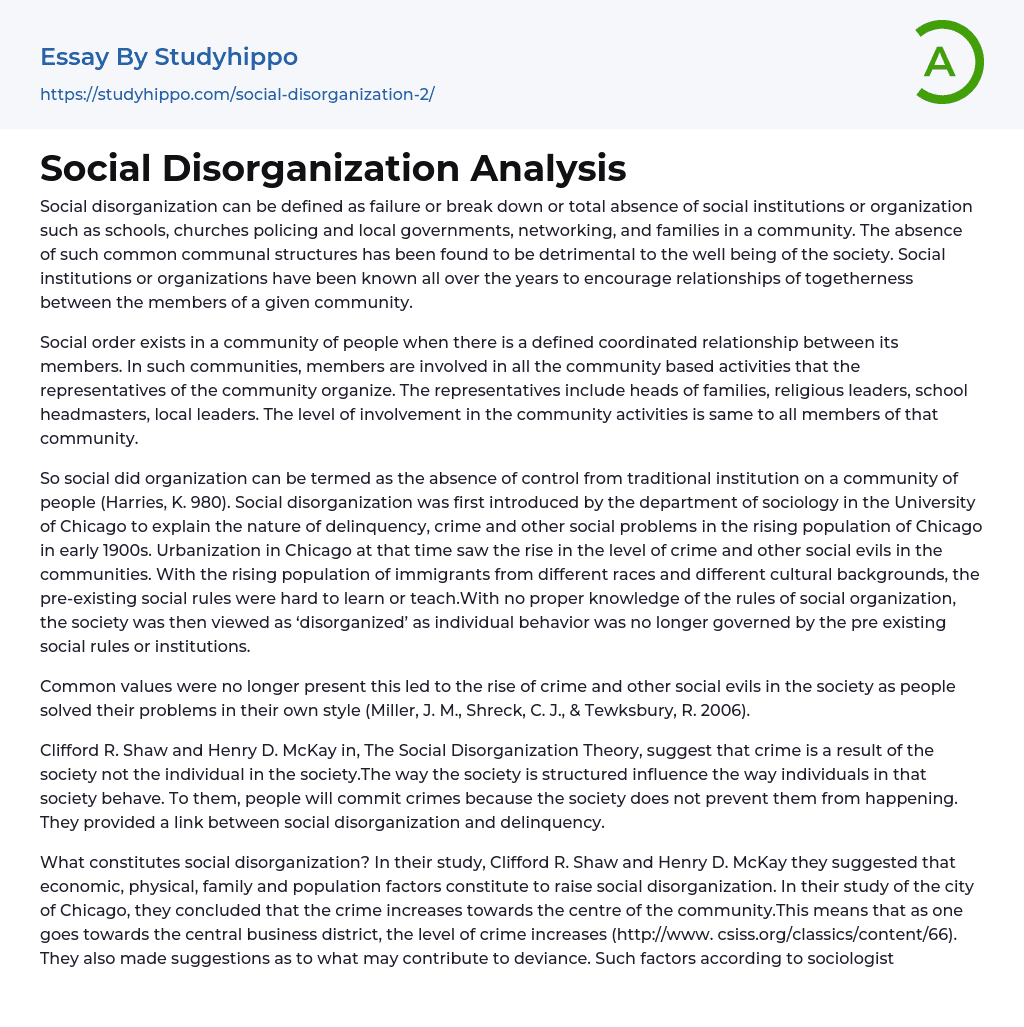Social disorganization refers to the fragmentation or lack of social institutions in a community, such as schools, churches, governments, networking, and families. This absence has a detrimental effect on society's overall well-being because these institutions promote relationships and unity among community members. Social cohesion within a community is attained through active engagement in organized activities overseen by heads of families, religious leaders, school administrators, and local authorities.
The concept of social disorganization (Harries, K. 980) arises from the absence of control exerted by traditional institutions within a community. The sociology department at the University of Chicago introduced this concept to explain the emergence of delinquency, crime, and various societal problems during the city's rapid urbanization in the early 1900s. The arrival of immigrants from diverse racial and cultural backgrounds contributed to an escalation in crime and
...social issues, complicating the process of acquiring or teaching existing social norms. Consequently, society was perceived as being 'disorganized' since individual behavior no longer adhered to established social rules or institutions.
According to Miller, Shreck, and Tewksbury (2006), the absence of common values resulted in the increase of crime and social issues, as individuals dealt with their problems in their own way. Clifford R. Shaw and Henry D.
In The Social Disorganization Theory, McKay suggests that crime is caused by society rather than by individuals within that society. The way a society is organized has a direct impact on the behavior of its individuals. According to McKay, individuals resort to criminal activities because the society fails to prevent such actions. They establish a connection between social disorganization and delinquency. What exactly defines social disorganization? In their research, Clifford R.
According to Shaw and
Henry D. McKay, social disorganization is caused by a combination of economic, physical, family, and population factors. In their research on Chicago, they found that crime rates escalate as one moves closer to the central business district. They also provided insights into the potential causes of deviant behavior (http://www. csiss.org/classics/content/66).
According to sociologist and criminologist, factors such as poverty, dilapidation, mixed use, and density, including high population in neighborhoods, as well as racial and ethnic differences, contribute to crime. The increasing chances of deviating and reducing social control power lead to deviance within society. Areas affected by poverty are harsh environments where individuals struggle to survive. In these environments, the survival of one person is crucial for maintaining the social structure of the community. Consequently, organized gangs tend to emerge in socially disorganized areas. The crime rate in a society is linked to its level of disorganization. However, the problems with organization in these areas do not imply a lack of organizations.
In the absence of societal structures, like-minded individuals tend to form informal associations, which, in the absence of social actions to prevent their formation, often evolve into gangs. The gang members share similar problems and are not concerned with the specific methods employed to solve them, as long as they provide relief. Unfortunately, the methods they typically resort to often involve criminal activities, contributing to social disorganization. Consequently, the perpetuation of their criminal behavior exacerbates social disorganization within society (Harries, K. 1980). To restore social order and organization, it is crucial to promote community institutions and organizations that foster a sense of unity among community members and encourage collaborative problem-solving.
Many politicians and policy makers frequently
advocate for immediate and temporary crime solutions, such as the apprehension and imprisonment of offenders. However, implementing such measures often results in the breakdown of social organizations, notably families, consequently leading to the collapse of the entire social structure. The negative consequences of this approach become evident when young individuals in society are incarcerated, hampering community growth and ultimately fostering poverty. To ensure social harmony, it is crucial to promote the unification of citizens and institutions that aim to cultivate unity.
- Criminal Justice System essays
- Animal Cruelty essays
- Charles Manson essays
- Crime Prevention essays
- Crime scene essays
- Criminal Justice essays
- Criminology essays
- Cyber Crime essays
- Damages essays
- Detention essays
- Distracted Driving essays
- Drug Trafficking essays
- Drunk Driving essays
- Forensic Science essays
- Gang essays
- Hate Crime essays
- Homicide essays
- Identity Theft essays
- Juvenile Crime essays
- Juvenile Delinquency essays
- Juvenile Justice System essays
- Law Enforcement essays
- Murder essays
- Organized Crime essays
- Penology essays
- Piracy essays
- Prison essays
- Property Crime essays
- Prostitution essays
- Punishment essays
- Punishments essays
- Rape essays
- Robbery essays
- Serial Killer essays
- Sexual Assault essays
- Sexual Assault on College Campuses essays
- Sexual Harassment essays
- Sexual Offence essays
- Stealing essays
- Surveillance essays
- Ted Bundy essays
- Victim essays
- Violent crime essays
- White Collar Crime essays




